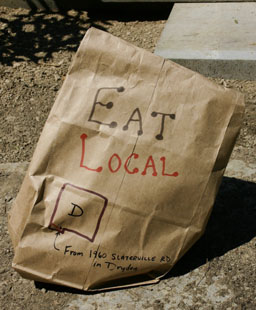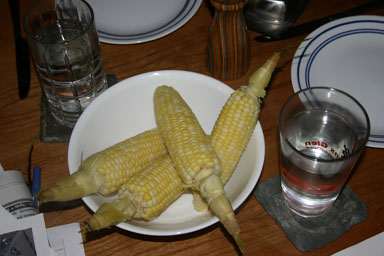August 7, 2007
Starting eating local
We decided back in June to start eating locally in August. We let our supplies dwindle coming up to the end of the month, though my being in the land of Burgerville didn't help with that. We gave away our remaining non-perishable goods, and stopped buying things that weren't from New York or Pennsylvania. The farewell party Angelika's Cornell co-workers threw her left us with a lot of leftover chocolate cake, so there hasn't been a chocolate shortage until now, but that's gone and we'll likely notice the difference soon.
Some folks are even helping us out with Dryden-fresh produce.

Besemer Flats produce inside: squash and zucchini.
Another highlight was tonight's Dryden sweet corn from Back to Basics. I definitely need to get more of that!
We've managed to borrow (!) a chest freezer and a dehydrator, so I think we'll end up well-stocked for the winter. We picked fruit at (well, Angelika really picked while I visited my parents in Corning) Little Tree Orchards over in Newfield, coming away with a huge pile of delicious tart cherries, black caps, and black raspberries. We've had some currants, and Ludgate Farms also had local currants, both red and black. The blueberries in the yard are just getting ripe now, and it looks like we'll have a better crop than we've had in a few years. We'll supplement that with more picking. I also bought three frozen chickens from a friend in Lansing, and reserved a turkey for Thanksgiving there too.
Between our own garden and local produce, it's not very hard to eat locally right now.
There are a few key things missing:
New York flour is sort of available, but I called New Hope Mills. The person I reached graciously went out to the mill floor to find out where their grains come from, but while they usually have New York grain, it also comes from elsewhere. I haven't managed to reach Champlain Valley during their office hours. If anyone knows of a source of New York (or PA) flour from New York (or PA) grain, please let me know. The flour milling part is less of a problem now, as we decided to invest in a small mill because...
So far, finding cereal grain seems to be a bigger problem. I really miss Grape-Nuts™, but we made some delicious granola in July using rolled grains - wheat, rye, spelt, oats - whose source we don't know. I've not yet found a source of rolled grain here, but it looks like we're just going to buy grain and do the "roll your own" thing with grain.
We're missing a key component of salads: cooking oil. I can substitute butter for a lot of things, but butter in salad just feels wrong to me. The NOFA-NY site lists a soybean oil producer I need to track down. We'll be out of our remaining open olive oil soon.
The question of "how local is local?" is a tough one. Having a Frito-Lay plant in Binghamton doesn't seem to me to make Fritos local, though maybe they'd like to talk about how many of their ingredients come from around here. Ice cream led to some tough conversations: Purity Ice Cream is made in downtown Ithaca (and is delicious), but the ingredients don't seem likely to stay local, especially the sugar. I should ask them to think about a local flavor made just from local ingredients, but I got excited enough about the question to actually make ice cream (photo gallery) from a recipe I found online. It's mostly local cream, eggs, maple syrup, and berries. (The cornstarch is leftover, but I'll find local eventually.)
We're also not worrying about organic, though organic producers do seem to do a better job of labeling where things came from. (I'm not fond of CAFOs, however, and hope to avoid their results even if they are local.)
It's also interesting to see some skepticism rising about eating locally. This New York Times op-ed (registration required) points out that there are cases where local isn't necessarily more energy-efficient. Sure - England's overworked soils can't compete with New Zealand's paradise for sheep. Growing chocolate and banana plants in greenhouses isn't likely to make sense either.
Driving inefficiencies in getting and distributing food may be higher for local food, and you can certainly burn away any energy savings in local food by driving to the far away grocery store or farmers' market too often. If you try to grow foods that aren't in season, you're also going to find yourself consuming a lot of energy.
It seems, though, like most of these problems can be avoided with a bit of common sense that our current system has encouraged us to forget. Eat foods in season, process foods you'd like to keep as energy-efficiently as you can, drive as efficiently as you can, and help build distribution networks that take advantage of whatever local economies of scale are available. It's not that it's impossible - it's just that we've spent the last century forgetting the skills needed to make that work. Part of the reason this is worthwhile is that it requires some lifestyle change to make sense, and those changes make sense too.
It's certainly interesting if at times frustrating to try to make sure you know where your food comes from. I'll have a lot more on this as we get further into it.
Posted by simon at August 7, 2007 8:06 PM in eating locallyNote on photos

Although the orthodoxy of this 'eat local' venture seems needlessly symbolic, arbitrary, and bordering on backwards and parochial, you may as well know where to get the good stuff. For corn, that would be the Fall Creek Market on Fall Creed Rd just past Red Mill. Most fresh sweet corn is wonderful, but their varieties are particularly outstanding.